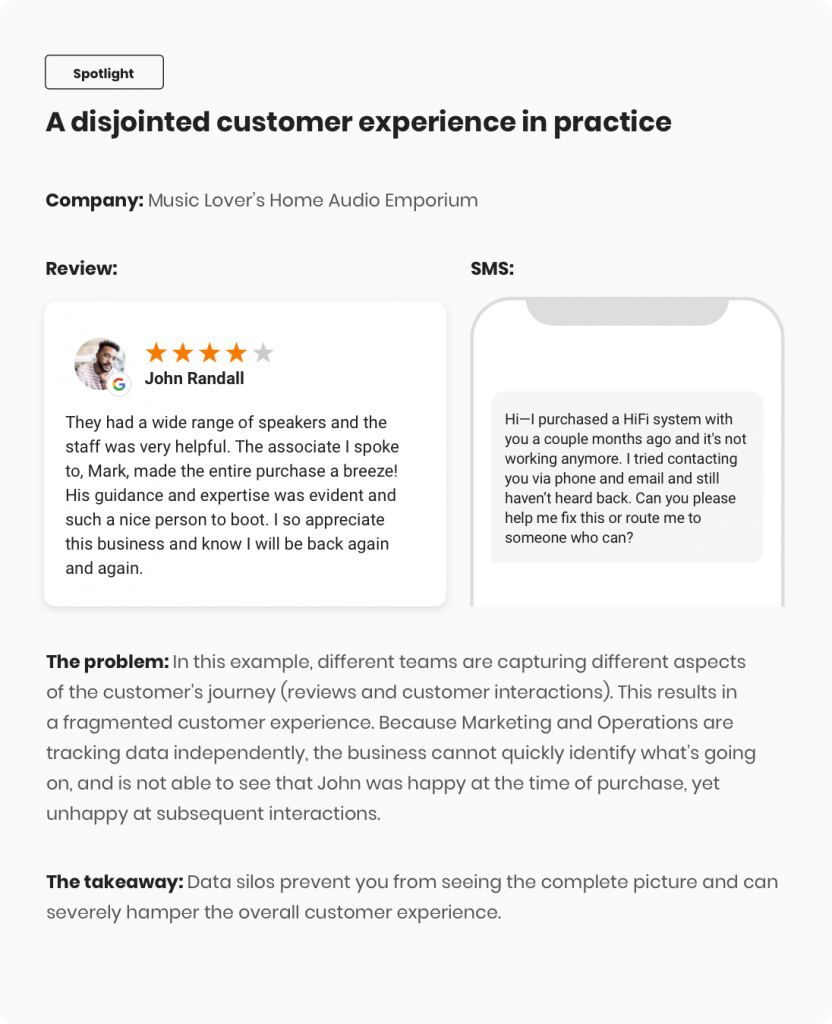Customer Experience Marketing and Customer Experience Management operate in silos: both organizationally and technologically. As a result, they utilize different sets of customer data, making it difficult to measure and communicate customer needs with the timeliness, authenticity, and care required to create raving fans.
The danger is real.
Gone are the days when businesses could rely solely on their products and services to differentiate themselves. In today’s competitive marketplace, it is easy to lose customers if they do not connect with a brand. Businesses must focus on offering superior customer experiences at every touchpoint: customers expect it, but only 8% believe they receive one.
Organizations can meet customer expectations by unifying CX Marketing and CX Management teams and allow them to tap into the “voice of the customer” to grow their businesses through happy customers. Here, we’ll outline how to do so.
Table of contents
Fragmented teams create fragmented experiences for customers.
Multi-location businesses often struggle to overcome the complexity and inefficiencies of using multiple applications to manage and optimize their marketing and customer experience operations.
Leaders on these teams are often measured on the amount and quality of the reviews generated by their customers; on the timeliness of their responses to customer queries; as well as on overall customer sentiment, yet they find that their use of fragmented point solutions keeps them from achieving true customer insights–and from acting upon them in real-time.
On the one hand, Customer Experience Marketing is responsible for building the lead pipeline, with reputation management and generating organic leads. And on the other, Customer Experience Operations measures customer sentiment and resolves problems before they escalate. Blurring the lines even further, both organizations use different tools to measure similar things, making it difficult to know what customers are experiencing in real-time.

For businesses to overcome these challenges, they need to invest in a customer experience platform that tracks every customer interaction in one place—allowing teams to influence and improve every touchpoint. Organizations must also evolve their philosophy and strategy to overcome the internal inefficiencies that lead to ineffective customer experience management.
Don’t trust your gut: measurement is the key to better CX.
Any organization that wants to raise the bar or continue to evolve needs to have a way to measure the customer experience at every point from end-to-end.
Most organizations measure customer experience with specific KPIs such as a customer satisfaction score, Net Promoter Score, or overall star rating. But in many cases, stop after optimizing their customer journey after achieving specific milestones. The best organizations go a step further and turn insights hidden within these metrics into actions that then improve the customer experience at every touchpoint.
As they say, “teamwork makes the dream work.”
Businesses need to be able to make critical decisions with confidence. This requires agility and communication to turn insights into action, which in turn, requires collaboration. Here’s how organizations can tear down silos to create better experiences for customers.
Map the customer journey and measure it at each stage
Every customer experience framework starts with mapping the customer’s journey; the customer journey represents your customer’s lifecycle from awareness to advocacy. Mapping the customer journey from end-to-end so your organization allows you to segment your customers based on their unique desires.

From there, teams can leverage data to create personalized customer experiences at every touchpoint. Good for a third of consumers that wish their experiences were “far more” personalized–and just as good for a business’ bottom-line. For example, brands focused on personalized customer experiences and customer loyalty as their top KPI had an ROI of 3x or more.
Work smarter, not harder: why an all-in-one CX solution helps teams stay on top of targets and goals.
You can’t improve what you don’t measure. As discussed above, teams that use different software solutions to track customer experience are at an inherent disadvantage. Fragmented tech keeps them from achieving true customer insights – and from acting upon them in real-time. This can result in the loss of new and returning customers.
In order to truly put customers at the center, businesses need access to the same real-world data into customer interactions across teams and in one place. Developing an omnichannel approach can help cross-functional teams stay on top of the customer experience and delight them at every step of the customer journey.
All-in-one customer experience solutions allow teams to get specific about their customer’s world and deliver content in their preferred channel, whether it be your website, webchat, social media, etc. It also allows teams to request and collect feedback directly through surveys.
When teams collaborate on a single platform, they can more easily share data and results from customer experience analytics, which helps ensure a shared understanding of what’s happening. Thus, the customer’s voice is heard.
Here are a few things that you should look for when choosing a customer experience software.
- Omnichannel interactions: Make sure that you have a one-stop solution for all your customer messaging needs, whether it’s Facebook Messenger, Livechat, or text messaging. This will help your team stay on top of all messages and provide a consistent experience across channels.
- Send customer surveys: Make sure that your customer experience software allows you to send customer surveys via text and email. Quality feedback helps you improve your touchpoints and delight your customers.
- Get actionable insights with natural language processing (NLP): It can be tough to get insights from reviews manually. But natural language processing can help you “find the needle in the haystack” and instantaneously view sentiment trends by topic, zoom in on specific keywords and adjectives, and put it all in context with verbatim snippets from review text. This allows businesses to make data-driven improvements across multiple locations and at the corporate and local levels.
Bring your team together for your customers.
Experiences are everything. Today, customers have more opportunities to remain connected with businesses––and each other––than ever before, and they expect businesses to serve their needs instantaneously. And if a business fails to meet customer expectations, a customer can easily find another option. In such an environment, businesses that win deliver superior customer experiences from the very first touchpoint.
Want to learn more about how to tear down walls in your business? Download our comprehensive guide.

Originally published









